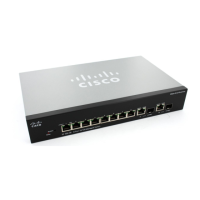Configuring IP Information
Management and IP Interfaces
Cisco Small Business 300 Series Managed Switch Administration Guide 176
15
• EUI-64—Select to use the EUI-64 parameter to identify the interface ID
portion of the Global IPv6 address by using the EUI-64 format based on a
device MAC address.
STEP 5 Click Apply. The switch is updated.
Defining an IPv6 Default Router List
The IPv6 Default Router List Page enables configuring and viewing the default
IPv6 router addresses. This list contains 0 or more routers that are candidates to
become the switch default router for non-local traffic. The switch randomly selects
a router from the list. The switch supports one static IPv6 default router. Dynamic
default routers are routers that have sent router advertisements to the switch IPv6
interface.
When adding or deleting IP addresses, the following events occur:
• When removing an IP interface, all the default router IP addresses are
removed.
• Dynamic IP addresses cannot be removed.
• An alert message is displayed after an attempt is made to insert more than
a single user-defined address.
• An alert message is displayed when attempting to insert a non-link local
type address, meaning 'fe80:'.
To define a default router:
STEP 1 In Layer 2 mode, click Administration > Management Interface > IPv6 Default
Router List.
In Layer 3 mode, click IP Configuration > Management and IP Interface > IPv6
Default Router List.
The IPv6 Default Router List Page opens.
This page displays the following fields for each default router:
• Default Router IPv6 Address—Link local IP address of the default router.
• Interface—Outgoing IPv6 interface where the default router resides.
• Type—The default router configuration that includes the following options:
- Static—The default router was manually added to this table through the
Add button.

